Is your garden soil is perfectly balanced? Do you maintain its condition with regular layers of compost and mulch? If so, you probably don’t need garden fertiliser.
But who keeps their middle-sized garden soil perfectly balanced?
Anyone? Is that a hand up at the back?
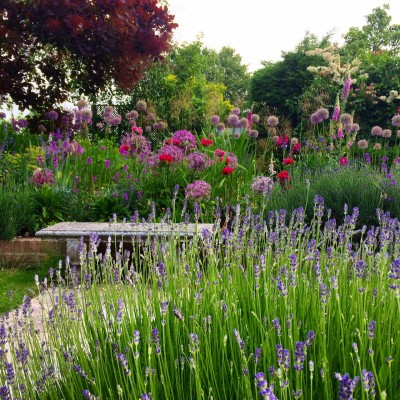
I couldn’t say that my garden is ‘perfectly balanced.’ It has its moments, but can be a bit scrappy close-up…
On the other hand, getting out the fertiliser packet can be daunting.
How much is too much? How often is too often?
Will my plants put on a lot of leafy growth at the expense of flowers or fruit if I get it wrong? Gaah…
Sometimes I slosh some liquid feed into a watering can (how much? How many litres is my watering can?). I tentatively pour it over my pots. It trickles out the bottom. I just hope the plants are picking up some nutrition as it flows past them.
So I’ve teamed up with Baby Bio® in a collaborative post to sort out what garden fertiliser really is and how to use it.
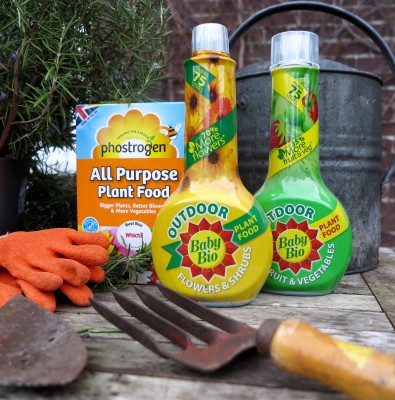
The Middlesized Garden getting to grips with the Outdoor Baby Baby Bio and Phostrogen. I only work with brands I use myself.
Of course, Baby Bio® would like you to buy their new garden fertiliser (Baby Bio Outdoor), but the advice from their experts will work whether you buy it or not. I’ve been paid a small fee, but would only work with brands that I believe to offer value to readers.
What exactly is garden fertiliser?
If you cover your beds with compost or manure, are you fertilising your garden?
Not exactly. You are improving your soil. Soil that is given at least one layer of compost a year has more nutrients. Plants in it will take up more nutrients. Worms and micro-organisms are happier. It is generally a better place for your plants to be.
Improving your soil is always very important if you want better flowers and fruit.
But it’s not quite the same as applying fertiliser
A fertiliser adds specific nutrients to individual plants, mainly nitrogen (N), phosphorus (P) and potassium (K) – known as NPK – plus other trace nutrients.
Fertilisers can be organic (fish-blood-and-bone or manure from chickens, rabbits, cows, horses and sheep). Or they are ‘inorganic’ – man-made concoctions of specific nutrients.
You’ll see the NPK rating on the packet of man-made fertiliser, given as figures. If you look at the bottom of a pack of Phostrogen® (Bayer’s soluble all-purpose plant food), for example, you’ll see the figures 16-10-24. That means it’s 16% nitrogen, 10% phosphorus and 24% potassium (the rest are trace elements), which gives it the right balance for all-purpose fertiliser.
Nitrogen (N) promotes healthy green foliage, phosphorous (P) develops a strong and healthy root system and potassium (K) helps plants produce abundant flowers.
Fruit and vegetables treated with fertiliser become more resistant to drought and disease (I was a bit surprised when Bayer told me that, but I have ferreted about and it does seem to be an established fact).
So fertilisers treat the plant. Soil conditioners treat the soil. The two work very well together.
And even if the condition of your soil is pretty good, there are still occasions when adding fertiliser can make a big difference (especially for pots and veg).
So when do I need fertiliser?
If your soil has problems, your plants will look spindly, discoloured or just won’t do very well. If the problem is lack of nutrients, adding fertiliser will sort it out.
For example, if you have very heavy clay soil it isn’t easy for plants to take up nutrients.
If there’s been exceptionally heavy rain, nutrients may have been washed out of the soil.
If your soil is very acid or alkaline, it may mean there isn’t enough nutrition in the soil.
In the long run, adding regular garden or mushroom compost or manure will help sort a lot of this out, but it’s not an instant effect. It can take 2-3 years for your soil to improve, during which time using fertiliser on particular plants will help enormously.
Plants in pots and hanging baskets need regular fertilising because they don’t have access to ‘free range’ soil.
Plants that grow fast or crop heavily need more nutrition than normal plants. That’s why tomato packets always say ‘feed fortnightly once the flowers have set’. ‘Hungry plants’ include peas, sweet peas, beans and roses.
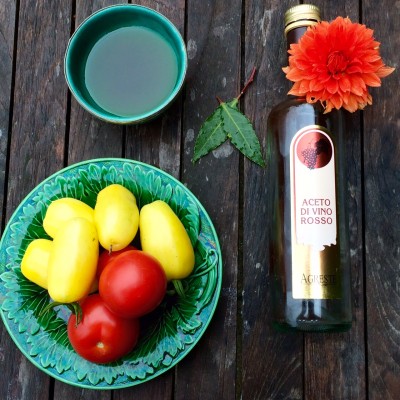
Tomatoes are a particularly ‘hungry’ crop. These are my home-grown tomatoes – I used fertiliser on them last year, and got a better harvest and the blight seemed to start later.
Should I test my soil to find out if I need to add fertiliser?
Soil testing kits measure the pH level, letting you know if your soil is acidic, alkaline or neutral. Different soils will make different nutrients available so some plants are more suited to one type of soil or another. For example ericaceous plants need acidic soil.
But, once again, that’s not exactly the same as knowing whether you need fertiliser or not. Your plants will show symptoms if they need feeding. The signs to look out for include
- browning of the leaves
- limp foliage
- accelerated and uneven growth
- buds forming but not blossoming
- fewer fruits, veg and flowers than usual.
Tick. I can certainly admit to one or more of those symptoms in the garden in every year.
How to use garden fertiliser like a pro
You know those bursting borders in professional gardens? Those plumptious, waving, confident plants in serried ranks of glorious colour? How do they do it?
Brands and strategies vary according to the philosophy of the head gardener, but fertilisers – either organic or inorganic – are involved.
(I shall be interested to see if I get any indignant tweets and comments from ‘proper gardeners’ saying that they never use fertilisers…although pro gardeners all undoubtedly prioritise proper soil conditioning and care)
The type of fertiliser you use depends on the type of plants you’re growing.
Liquid fertilisers are good for:
An instant pick-me-up: If plants are hungry or a little malnourished (showing more than one of the symptoms above), a liquid fertiliser, like Baby Bio® Outdoor is ideal. Mixed in a watering can and applied directly, the nutrients are available immediately to the plant.
For very full borders with lots of annuals: If you want to pack your border with flowers, Baby Bio® Outdoor plant foods also contain biostimulants, which help plants to absorb the nutrients available more effectively. When Bayer tested Baby Bio® Outdoor Flowers & Shrubs under controlled conditions, they proved it could produce up to 70%* more flowers.
Apply every fortnight to get great results.
Granular fertilisers are good for:
Borders full of roses and slow growth flowering perennials. These plants benefit most from a granular slow release, such as Toprose Gold. It’s a granular slow release fertiliser with added seaweed extract that helps the plants take up the nutrients in the feed – which means foliage is more abundant and greener.
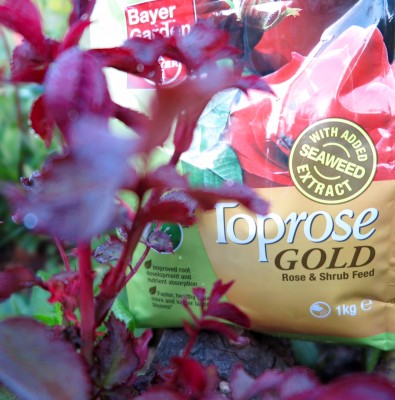
Toprose Gold with emerging rose foliage. But it’s an all-purpose fertiliser so you can use it on other shrubs, too.
Flowers should also last longer.
The dos and don’ts of granular fertiliser
Just sprinkle some around the base of the plant and hoe it in. Do it at the start of the season (when growth is just starting to appear) and again mid way through (around mid-summer) and you’ll get great results.
Getting granules on the foliage could burn it though, so be careful to make sure the feed goes on the soil. This will be easier to manage the earlier in the season you feed.
Do you need to vary quantities for different plants?
A standard all-purpose fertiliser like Phostrogen® is suitable for a wide range of garden plants including perennials, grasses and shrubs.
Ericaceous plants, such as rhododendrons, however, require a more specialist plant food.
Feeding individual plants in a border with different types and amounts of feed can be a challenge, but not one you need to worry about. General all-purpose feeds, such as Baby Bio® Outdoor and Phostrogen®, will work with all plants. The balance of nutrients in these feeds means you don’t have to worry about differentiating between plants.
These feeds don’t leach easily from the soil but you may need to feed a little more if your soil is sandy.
And if you have plants in the border that prefer poor soil, such as gaillardia, hellebores, mahonia or sedum, then just don’t fertilise them.
If you have a packed border there are a few other basics you can do to keep it blooming. Check for pests and diseases; catching them early makes it much simpler to tackle them.
Cutting back old foliage and deadheading regularly increases the air movement, helping to make sure they are in good health and water regularly, particularly in warm dry weather.
What everyone needs to know about garden fertiliser and pots
Plants in pots and hanging baskets run out of nutrition very quickly.
I have a number of evergreen box in pots. I’ve been advised to take them out of their pots once every two years, give them a hard root prune and then return them to fresh potting compost.
Then, as they’ll exhaust the nutrients in the potting compost fairly soon, I’ve been told to fertilise, which I can either do with a liquid or granular feed every two weeks or a slow-release fertiliser at the start of the season.
Slow or controlled release fertilisers degrade slowly, usually under the influence of soil micro-organisms and dependent on the soil temperature, to release their nutrients. They are usually organic and include hoof, horn and bone meal.
Long established perennials in pots particularly benefit from a controlled-release fertiliser, which gives them a constant supply of nutrients during the growing season, tailing off as plant activity decreases later in the year.
Liquid feeds are for a quick pick-me-up. A plant gin-and-tonic or smoothy.
Last September, I bought a spiral box from a field in Dorset (see How to Buy Sensational Topiary on A Middlesized Budget). It is my pride and joy, but it needed a drastic root prune to get it from the field to the pot. Since then it has sat there. It isn’t putting on new growth like my other box in pots.
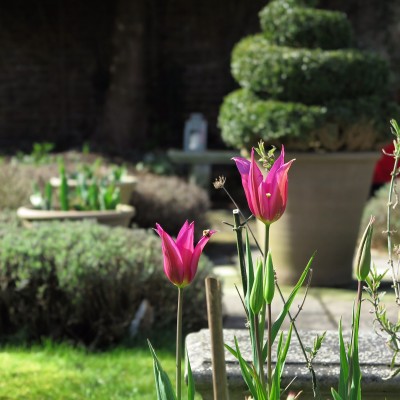
This topiary spiral is my pride and joy, but if I don’t feed it, there may be awful consequences. It’s already looking a bit brown at the side…
So I have given it emergency treatment with Baby Bio Outdoor liquid feed to rescue it. I will repeat this every two weeks until early August. I’m also going to water it more. In spite of the rain we’ve had, the soil feels a little dry.
Adding a liquid or soluble fertiliser at the time of potting on and as a top dressing will always give the plants a boost, as does giving them a good dousing of water in the evening, particularly in warm and dry conditions.
Foliar feeds spray onto the leaves. All other fertilisers should never touch the leaves.
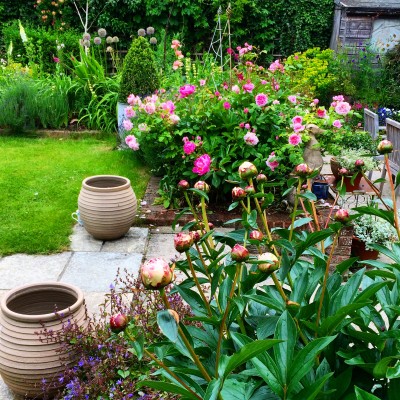
Because my pots often look scrappy, I think some of them look better empty. When I plant these up, I will feed them regularly, which hasn’t been the case in the past.
Other pots in the garden are seasonal. I grow tulips, pelargoniums, helichrysum, various plants I can’t fit into borders and herbs.
But I haven’t been particularly successful in getting my pots to look abundant. This is almost definitely a result of the plant not getting enough water or food.
Deadheading seasonal plants and keeping the foliage tidy can make a difference, encouraging further flowering in plants like petunias and geraniums.
Easy ways to veg growing success
The veg patch is where fertilisers come into their own. Vegetables grow fast. If you want them to crop heavily, then they’ll need lots of nutrients. I’ve admitted to disappointment in my veg patch in earlier posts. Undoubtedly that has been due to not enough fertiliser, although I do mulch the beds with compost thoroughly every year.
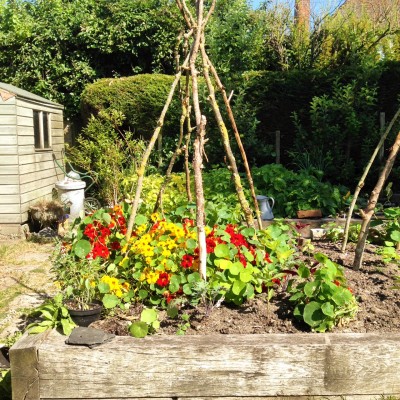
Beans are hungry plants and need feeding while they’re producing beans (the nasturtiums are self-seeder companion plants to the young beans).
If you have rabbits, cows, chickens, horses or sheep, then their well-rotted manure will make a good fertiliser for vegetables. At least a year is needed between it emerging from the rabbit (cow, horse etc) and going onto your veg patch – or it could burn the plants.
Grass clippings are also a good free fertiliser (I haven’t tried this yet, but plan to). I have been advised that an inch or so of grass clippings as a mulch over the veg border is an excellent way of topping up nutrition, but NOT if you use weed-killers on your lawn or lawn weed-and-feed!
Or you can buy fertiliser. A feed like Baby Bio® Outdoor Fruit & Vegetables can give your crops a real boost. Bayer’s tests showed that plants treated with Baby Bio Outdoor Fruit & Vegetables had up to 35% more fruit and veg compared to feeding with a standard NPK fertiliser.
If you’re limited on space you can grow fruit and veg in pots and containers. If you do this, keeping the plants well fed is particularly important.
They’re productive hungry plants so they’ll quickly use up whatever is available in the compost.
No more mistakes with garden fertiliser?
One of the main things stopping me using garden fertiliser properly is all that measuring.
To make it easy, first know your watering cans.
The can on the right is a super-slim Rhino Easi-Can, the middle is standard plastic from a supermarket and on the left is my mother’s vintage watering can. But all hold 10 litres. If you have what is clearly a smaller can, like the blue one on the far left, you’ll need to use a kitchen measuring jug to check how much water it holds (4 litres in this case).
Then you spoon out the amount of fertiliser per litre according to what it says on the pack. Baby Bio ® Outdoor, for example, has a measuring cap. You just add 10ml for every litre of water.
If, like me, you lose caps, then 10ml is a standard classic dessert-spoon. If you peer at the pictures of Outdoor Baby Bio and Phostrogen on my garden table, you will spot that I lost the cap before I could even photograph it, let alone use it.
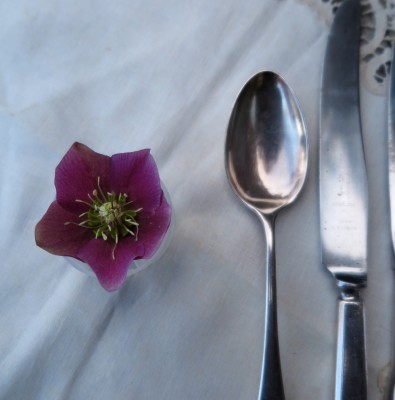
If you lose the cap, use a standard dessert-spoon (though not one of those modern ones that are almost flat)
What to do if too much water trickles out of the pot
This happens when compost gets too dry. The water sits on the top of the compost for a moment, then rushes through the compost and straight out the bottom of the pot.
If this happens, put the pot on a tray when you water and it will suck up the water and feed gradually. If you can’t heave your massive pot onto a drip tray, pour a little in. Wait a few minutes, then pour a little more in for a second – and then a third – time.
How much does using fertilisers cost?
One bottle of Baby Bio Outdoor Fruit & Vegetables costs £5.99 and gives you 75 litres of liquid fertiliser. That’s seven and a half 10L watering cans.
There isn’t an exact measure on how much feed you should give any individual plant – it varies according to soil type and plant needs.
But incorporating the liquid feed (every two weeks) into your normal watering routine should work.
Remember that plants needs a good puddle of water around them when they’re watered, not just a few splashes.
What Baby Bio® says about its new outdoor feed:
‘New this season Baby Bio® Outdoor has a powerful effect. It has all the nutrients plants need and its unique formulation, which contains biostimulants, means plants can take them up and use them to the absolute max. What does this mean for your garden? It means healthy greener leaves, plants bursting with long-lasting, beautiful flowers and up to 35% more fruit and veg, compared to using a standard NPK fertiliser.
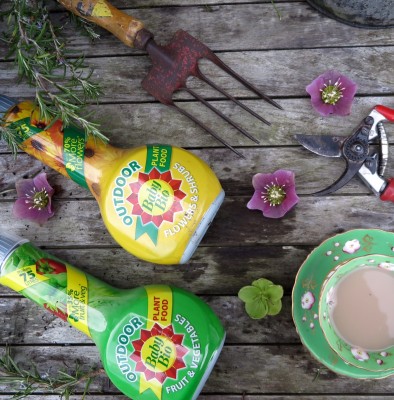
To help people realise the full potential of their plants, Baby Bio® has launched the Big Boost Challenge. Just a small change to the watering routine – add 10ml of Baby Bio® Outdoor to the watering once a fortnight – will make a big difference.
- In 7 days their plants will have healthier, greener leaves.
- Within 4 weeks the plants will be bigger with stronger roots for better growth.
- They will see amazing results in 6 weeks, plants producing up to 70%* more flowers.
- With more blooms and flowers compared to unfed, which means there’ll be flowers throughout the season.
Phostrogen® is a British brand that’s been feeding the garden since 1960. This year it has been rejuvenated for the next generation of gardeners and a new version launched specifically for container plants, Phostrogen® Patio Plant Food.
Toprose has been complemented by Toprose Gold. The gold standard in rose feed, Toprose Gold has added seaweed extract feed, which increases root development and helps plants absorb all the nutrients available to them.
Baby Bio and Phostrogen are registered trademarks of Bayer CropScience.’
Well, I must be off to rake in Toprose Gold around my many rose bushes in the front garden, as well sprinkling it into the pots of evergreens at the back.
Do join the Middlesized Garden every Sunday morning for all sorts of garden tips and posts. Just leave your email in the box on the top right and we will whizz into your inbox as soon as the sun comes up.
from The Middle-Sized Garden http://www.themiddlesizedgarden.co.uk/how-to-use-garden-fertiliser-for-amazing-results/
No comments:
Post a Comment